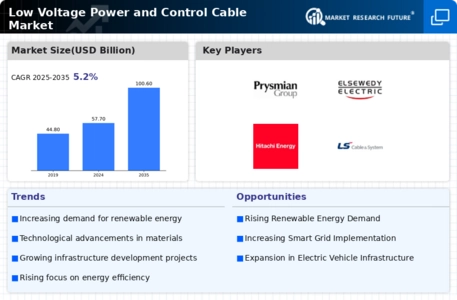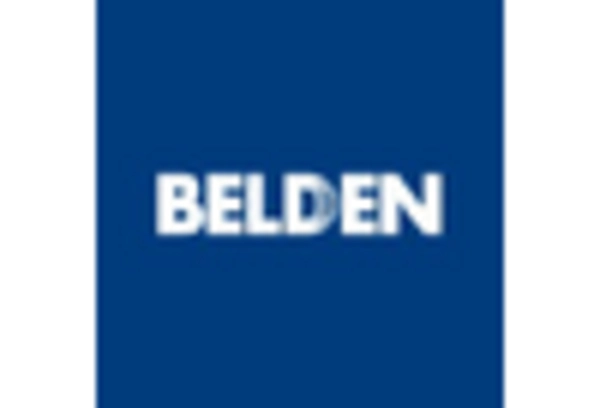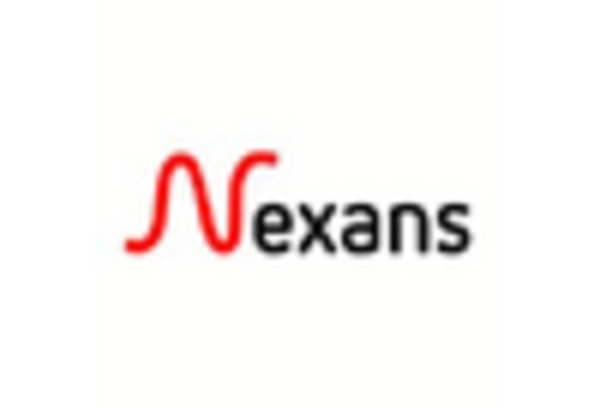Rising Demand for Renewable Energy
The increasing emphasis on renewable energy sources is driving the Low Voltage Power and Control Cable Market. As countries strive to meet energy transition goals, the installation of solar panels, wind turbines, and other renewable energy systems necessitates the use of low voltage cables for efficient power distribution. In 2025, the renewable energy sector is projected to account for a substantial share of the overall energy mix, further propelling the demand for low voltage power and control cables. This trend indicates a shift towards sustainable energy solutions, which in turn enhances the market's growth potential. The integration of low voltage cables in renewable energy projects is essential for ensuring reliable and safe energy transmission, thereby solidifying their role in the evolving energy landscape.
Expansion of Smart Grid Technologies
The advent of smart grid technologies is significantly influencing the Low Voltage Power and Control Cable Market. Smart grids require advanced infrastructure to facilitate two-way communication between utilities and consumers, which in turn necessitates the deployment of low voltage power and control cables. As of 2025, investments in smart grid initiatives are expected to rise, driven by the need for improved energy efficiency and reliability. This expansion is likely to create a robust demand for low voltage cables, as they are integral to the operation of smart meters, sensors, and automated systems. The integration of these technologies not only enhances grid resilience but also supports the transition towards more sustainable energy practices, thereby fostering growth in the market.
Urbanization and Infrastructure Development
The ongoing trend of urbanization is a key driver for the Low Voltage Power and Control Cable Market. As urban areas expand, there is a heightened need for reliable electrical infrastructure to support residential, commercial, and industrial developments. In 2025, urbanization is projected to continue at a rapid pace, leading to increased investments in infrastructure projects. This surge in construction activities necessitates the installation of low voltage power and control cables for effective power distribution and control. The demand for these cables is likely to be further amplified by government initiatives aimed at modernizing urban infrastructure, which underscores the critical role of low voltage cables in facilitating urban growth and development.
Technological Innovations in Cable Manufacturing
Technological advancements in cable manufacturing processes are shaping the Low Voltage Power and Control Cable Market. Innovations such as improved insulation materials, enhanced conductivity, and advanced manufacturing techniques are leading to the production of more efficient and durable cables. As of 2025, these technological improvements are expected to enhance the performance and reliability of low voltage cables, making them more appealing to end-users. The introduction of smart cables, which can monitor their own performance and detect faults, is also likely to gain traction in the market. Such innovations not only improve the operational efficiency of electrical systems but also contribute to the overall growth of the low voltage power and control cable market.
Regulatory Support for Electrical Safety Standards
Regulatory frameworks aimed at enhancing electrical safety standards are influencing the Low Voltage Power and Control Cable Market. Governments and regulatory bodies are increasingly implementing stringent safety regulations to ensure the reliability and safety of electrical installations. As of 2025, compliance with these regulations is expected to drive the demand for high-quality low voltage power and control cables that meet safety standards. This regulatory support is likely to encourage manufacturers to innovate and improve their product offerings, thereby fostering competition in the market. The emphasis on safety not only protects consumers but also enhances the credibility of the low voltage cable industry, contributing to its growth and sustainability.


















Leave a Comment